Blogs
Mark Milburn’s Cornish Wreck Ramblings, Part 13: Dollar Cove, just what is the ‘truth’?
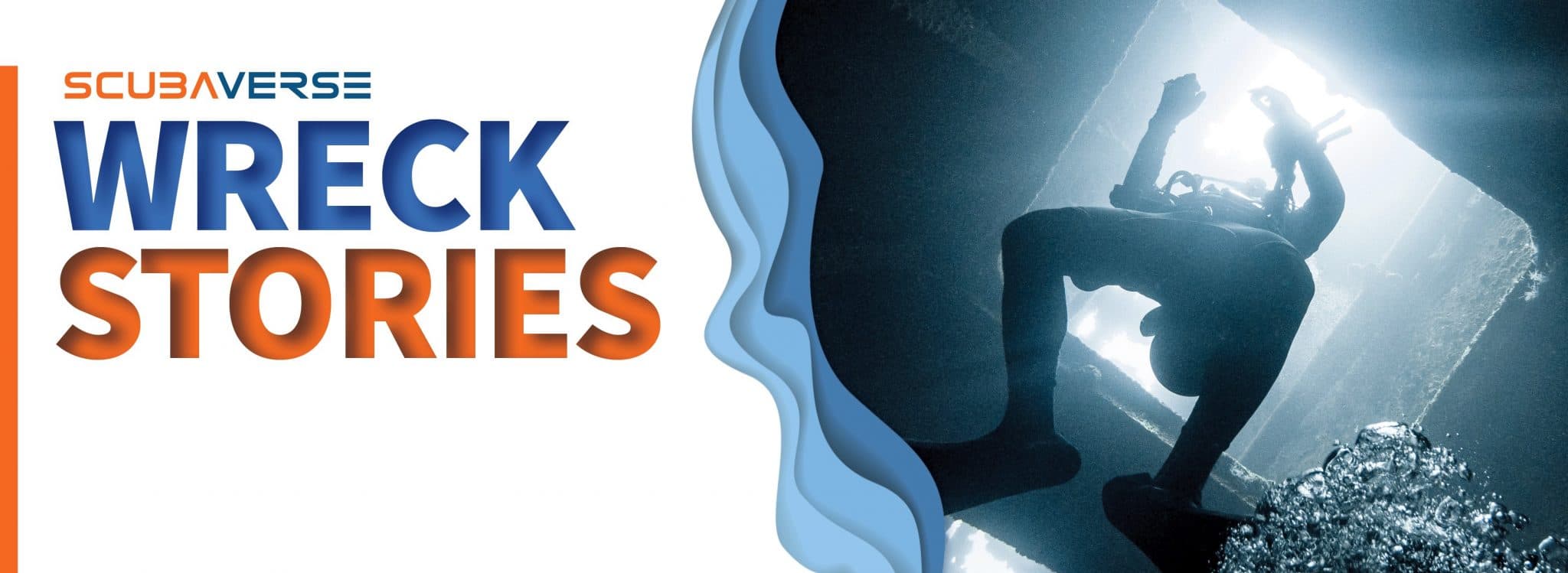
Reprising our popular series of Cornish Wreck Ramblings by Mark Milburn…
Part 13: Dollar Cove, just what is the ‘truth’?
For many years treasure hunters have been searching for the fabled “Dollar Cove” wreck. Dollar Cove’s actual name is Jangye Ryn; it got the name “Dollar Cove” from the silver pillar dollars, pieces of eight, that used to regularly wash ashore. Most stories online state that coins washed up from the 17thC wreck are dated up to around 1775, so late 18thC. The San Salvador is quite often listed as being the dollar wreck, it was a hundred years too early. Although it was reportedly wrecked near Gunwalloe Church Cove, the wrong side of St Winwalloe Church to be the Dollar wreck.
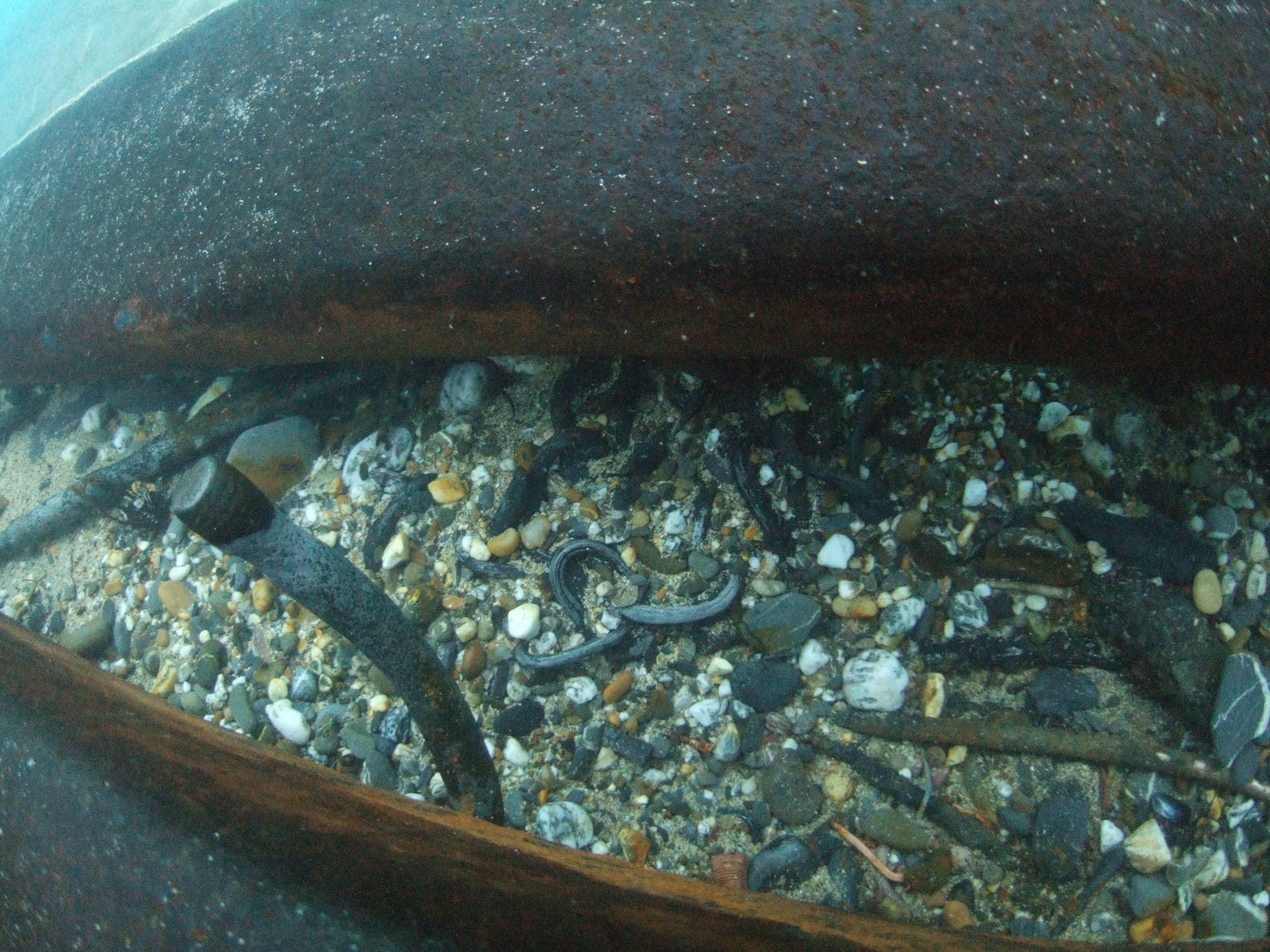
Underwater artefacts
Within the church records of St Winwalloe, there is an entry from 1787, it states that a Portuguese wreck occurred with several bodies washed ashore. There are no records of this wreck anywhere, which is no surprise. There are many wrecks along that piece of coast without any records.
The current suspect, is the Rio Nova, it sank in 1802, near Penzance. The whole of Mounts Bay was classed as close to Penzance, back in those days. The Rio Nova was carrying 19,000 silver coins, 12,500 of which were recovered at the time. Many coins have washed up over the years, on one day in the late 19th century, 484 coins were said to have washed up one night. The main problem with the Rio Nova being the dollar wreck, is that divers said they found the Rio Nova near Penzance many years ago.
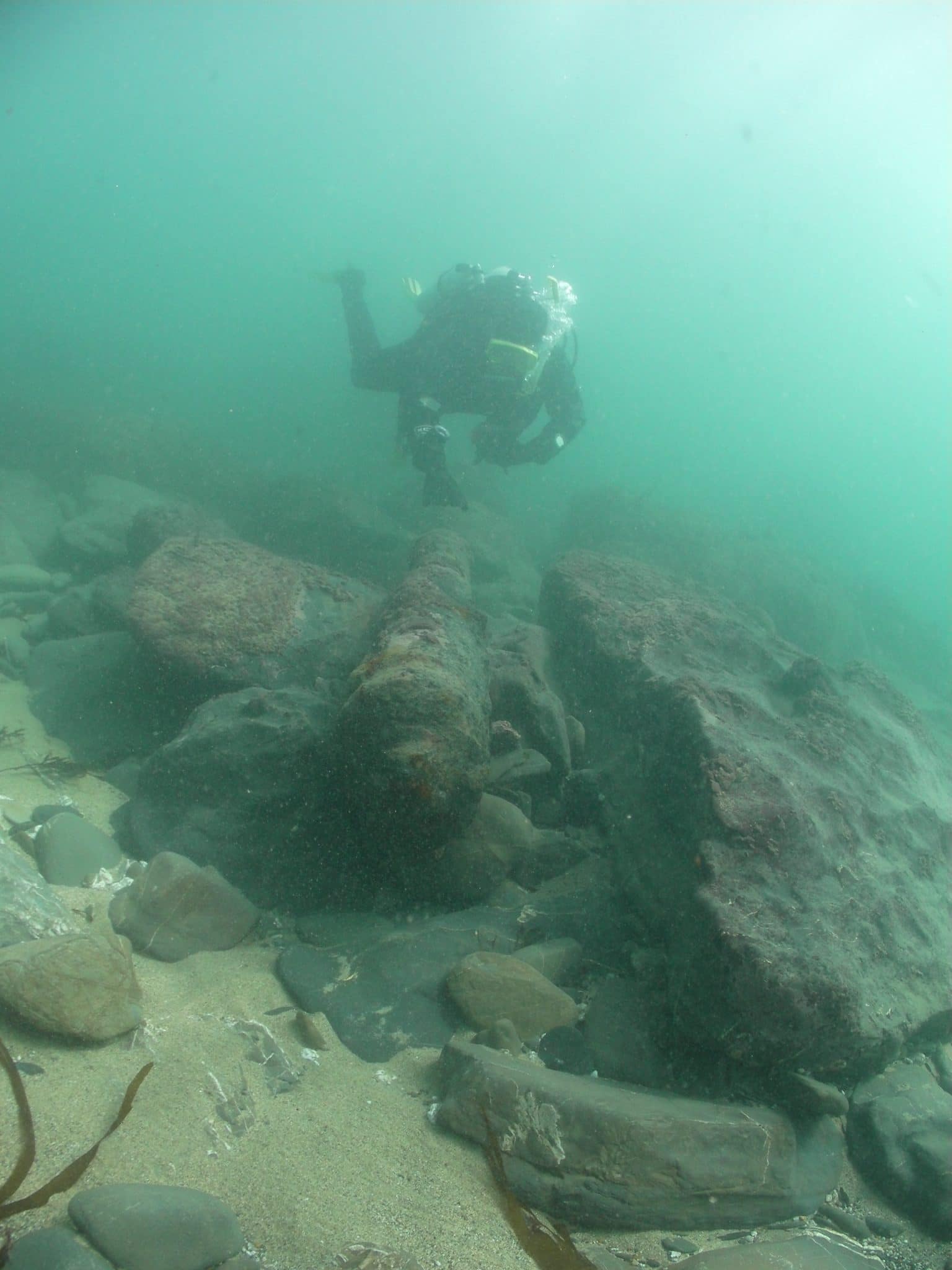
A lone 18th Century Cannon, possibly from the Dollar Cove Wreck
Some other sources of information state:
A Spanish ship struck the cliffs midway between Gunwalloe Church Cove and the fishing cove, half a mile westward. She broached, end to end, and spilled her cargo of pieces of silver. In 1845 a limited company tried to recover the cargo by damming the mouth of the gully with the intention of pumping it dry at low water. However, their attempts were thwarted by a southwest gale which swept the dam away. (2)(3)(4)
The distance between Church Cove and Fishing Cove is a couple of miles, the gully they dammed was believed to be the one on the headland, between Church Cove and Dollar Cove.
Another attempt was made in 1847 when a gang of miners were hired to cut a passage down and steps down the cliff and sink a shaft 3 metres in diameter and 25 feet deep in the rocks. The miners then drove 40 feet under the gully, but no coins appeared; but the sea did and they just escaped with their lives. (2)(3)(4)
Some of their efforts are still visible around the headland, the main one being a cutting on the far most northern corner.
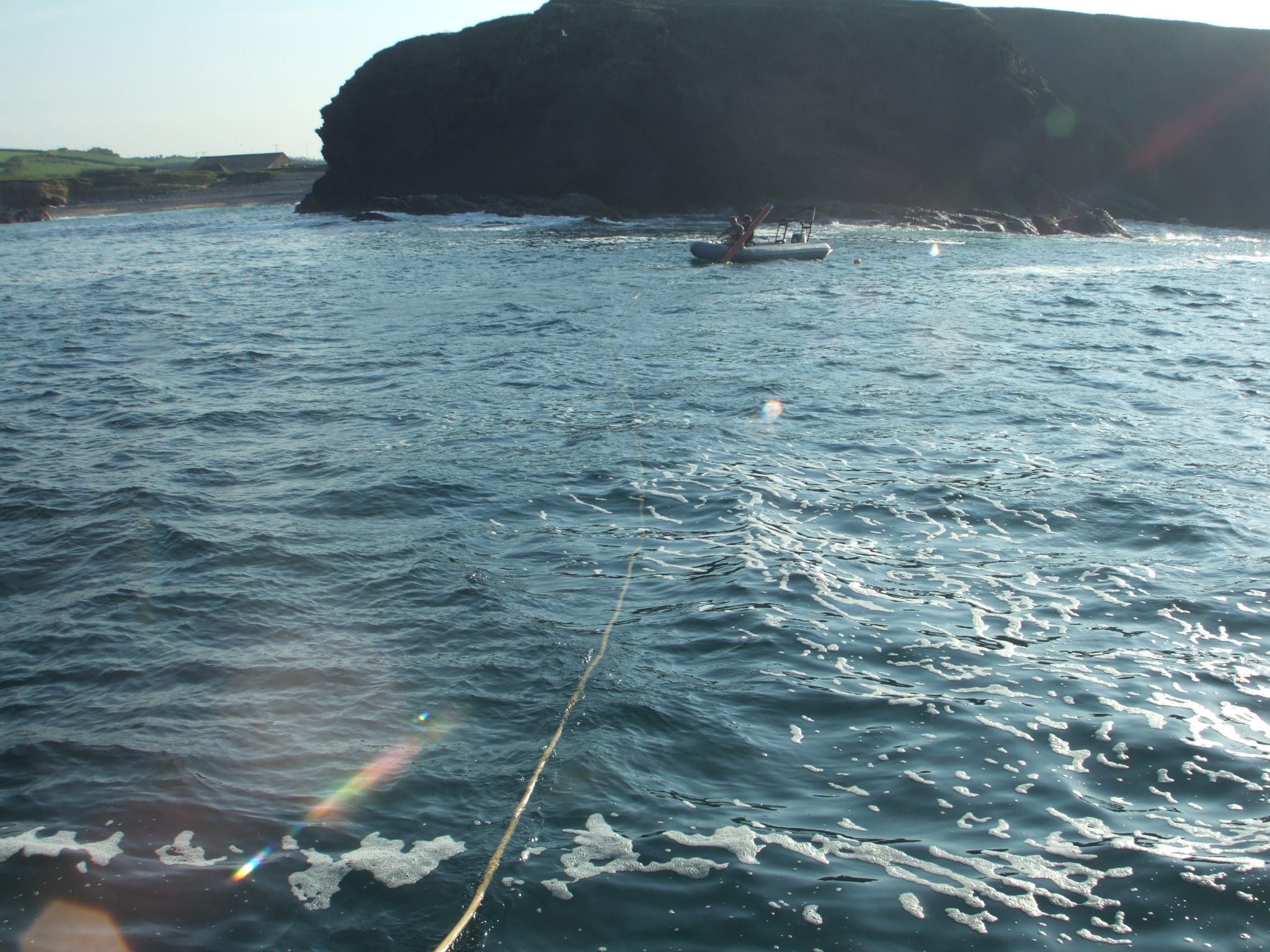
A 2006 attempt to locate the treasure
Thirty years later, a Mr Boyd, with engineers and divers, attempted to pump out and sieve the contents of the 1847 shaft. No dollars were found so they decided to blow up the shaft and sieve it but to no avail. (3)(4)
In 1877 two bankers from Helston sold 200 shares at £3 each to finance another attempt. The circular mentioned several ships rather than one and the promoter John Toy had occasionally picked up dollars around the cove. He had divers working within a caisson, but nothing was found during the first season. However, the following year an unspecified quantity of coin was recovered, but it was insufficient to repay the shareholders and the company went into liquidation. (3)(4)
There are several ships in the area, this story seems to have been echoed many years later, on another wreck in Cornwall.
In June 1890 another attempt was made by the Liverpool salvage steamer ZEPHYR, but it came to nothing. The last attempt was made by a London businessman, who hired a suction dredger and shifted thousands of tons of sand, but no coins were found.
Since the 1890 attempt, many people have looked, including the legendary Roland Morris. He implied that he may have known where it was, after an argument with the National Trust about ‘rights to wreck’, he left. The NT told Roland to tell them where it was, he just laughed and told them he never would,
The last I can remember was in 2007, when a business man from Chippenham, hired a boat with some local divers including myself, to try and excavate the site. We visited twice in 2007 and recovered hundreds of artefacts but no coins. The first visit found the inlet, which was dammed in 1845, to be completely void of sand, nothing was found apart from some steel beams and a sounding lead. So either all the coins had all been removed, or they were never there in the first place. He is still looking.
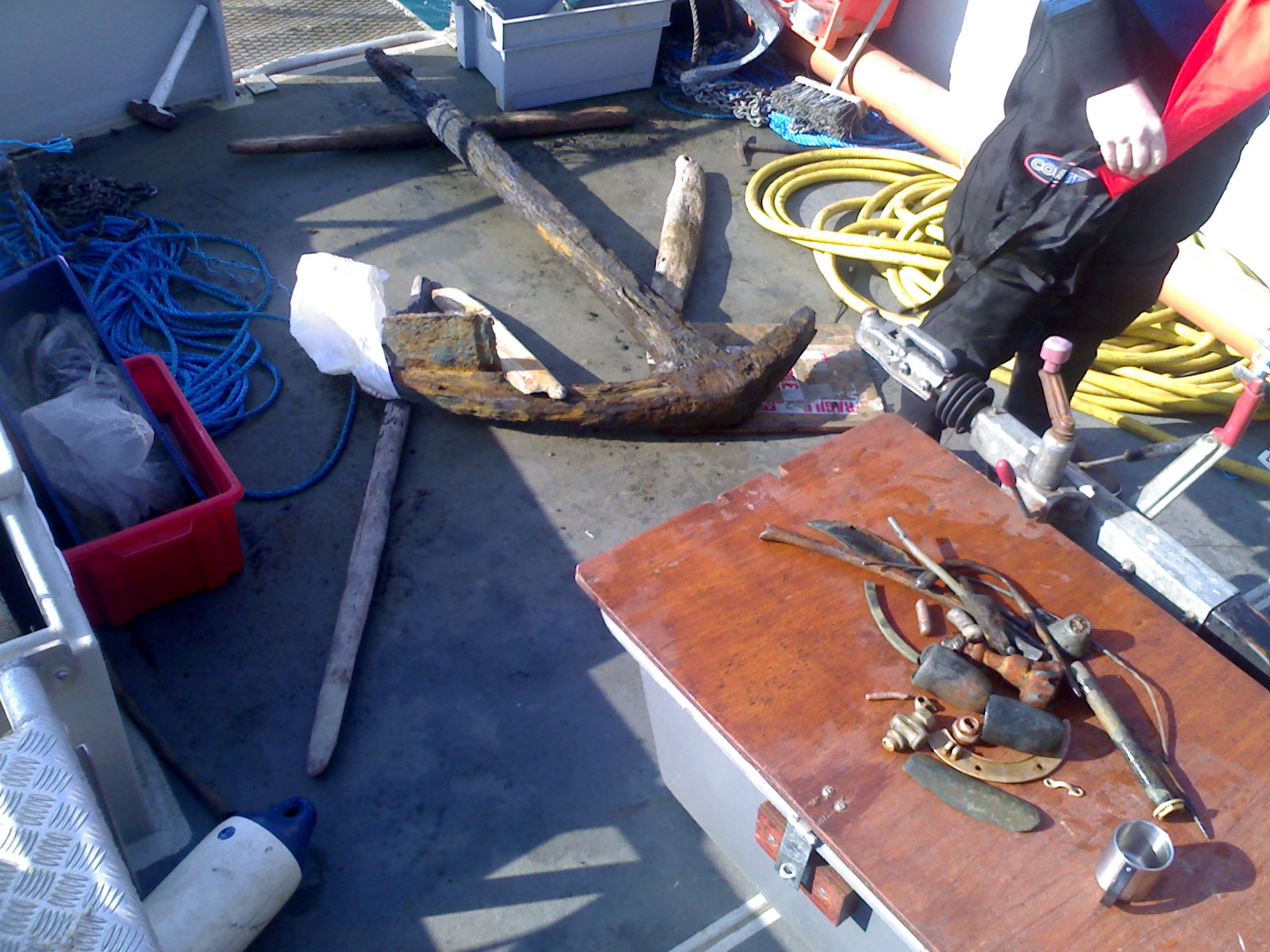
Artefacts recovered during a 2006 attempt
Notes:
(2) Richard Larn 1987 A Diver Guide, Dive South Cornwall – 2nd Edition Page(s)116-17
(3) by Richard Larn 1996 A Diver Guide, Dive South Cornwall – 3rd Edition Page(s)166-69
(4) R. Larn 1983 The Diver Guide to South Cornwall – 1st Edition Page(s)134-35
Find out more about Mark and Atlantic Scuba at www.atlanticscuba.co.uk
Blogs
Northern Red Sea Reefs and Wrecks Trip Report, Part 3: The Mighty Thistlegorm

Jake Davies boards Ghazala Explorer for an unforgettable Red Sea diving experience…
Overnight, the wind picked up, making the planned morning dive a bit bumpy on the Zodiacs to the drop point on Thomas Reef. There, we would dive along the reef before descending through the canyon and then passing under the arch before ascending the wall with a gentle drift. The site provided great encounters with more pelagic species, including shoals of large barracuda, tuna, and bigeye trevally.
Once back on the boat, it was time to get everything tied down again as we would head back south. This time, with the wind behind us, heading to Ras Mohammed to dive Jackfish Alley for another great gentle drift wall dive before then heading up the coast towards the Gulf of Suez to moor up at the wreck of the Thistlegorm. This being the highlight wreck dive of the trip and for many onboard, including myself, it was the first time diving this iconic wreck. I had heard so much about the wreck from friends, and globally, this is a must on any diver’s list. Fortunately for us, there was only one other boat at the site, which was a rarity. A great briefing was delivered by Ahmed, who provided a detailed background about the wreck’s history along with all the required safety information as the currents and visibility at the site can be variable.

Kitting up, there was a lot of excitement on deck before entering the water and heading down the shoreline. Descending to the wreck, there was a light northerly current which reduced the visibility, making it feel more like the conditions that can be found off the Welsh coast. At 10m from the bottom, the outline of the wreck appeared as we reached the area of the wreck which had been bombed, as our mooring line was attached to part of the propeller shaft. Arriving on deck, instantly everywhere you looked there were many of the supplies which the ship was carrying, including Bren Carrier tanks and projectiles that instantly stood out.

We headed around the exterior, taking a look at the large propeller and guns mounted on deck before entering the wreck on the port side to take a look in the holds. It was incredible to see all the trucks, Norton 16H, and BSA motorcycles still perfectly stacked within, providing a real snapshot in time.

Overall, we had four dives on the Thistlegorm, where for all of the dives we were the only group in the water, and at times, there were just three of us on the whole wreck, which made it even more special, especially knowing that most days the wreck has hundreds of divers. Along with the history of the wreck, there was plenty of marine life on the wreck and around, from big green turtles to batfish, along with shoals of mackerel being hunted by trevally. Some unforgettable dives.

The final leg of the trip saw us cross back over the Suez Canal to the Gobal Islands where we planned to stay the night and do three dives at the Dolphin House for the potential of sharing the dive with dolphins. The site, which included a channel that was teeming with reef fish, especially large numbers of goatfish that swam in large shoals along the edge of the reef. These were nice relaxing dives to end the week. Unfortunately, the dolphins didn’t show up, which was okay as like all marine life they are difficult to predict and you can’t guarantee what’s going to be seen. With the last dive complete, we headed back to port for the final night where it was time to clean all the kit and pack before the departure flight the next day.

The whole week from start to finish on Ghazala Explorer was amazing; the boat had all the facilities you need for a comfortable week aboard. The crew were always there to help throughout the day and the chefs providing top quality food which was required after every dive. The itinerary providing some of the best diving with a nice mixture of wreck and reef dives. I would recommend the trip to anyone, whether it’s your first Red Sea liveaboard in the Red Sea or you’re revisiting. Hopefully, it’s not too long before I head back to explore more of the Red Sea onboard Ghazala Explorer.

To find out more about the Northern Red Sea reef and wrecks itineraries aboard Ghazala Explorer, or to book, contact Scuba Travel now:
Email: dive@scubatravel.com
Tel: +44 (0)1483 411590
Photos: Jake Davies / Avalon.Red
Blogs
Northern Red Sea Reefs and Wrecks Trip Report, Part 2: Wall to Wall Wrecks

Jake Davies boards Ghazala Explorer for an unforgettable Red Sea diving experience…
The second day’s diving was a day full of wreck diving at Abu Nuhas, which included the Chrisoula K, Carnatic, and Ghiannis D. The first dive of the day was onto the Chrisoula K, also known as the wreck of tiles. The 98m vessel remains largely intact where she was loaded with tiles which can be seen throughout the hold. The stern sits at 26m and the bow just below the surface. One of the highlights of the wreck is heading inside and seeing the workroom where the machinery used for cutting the tiles are perfectly intact. The bow provided some relaxing scenery as the bright sunlight highlighted the colours of the soft coral reef and the many reef fish.

Following breakfast, we then headed to the next wreck, which was the Carnatic. The Carnatic is an 89.9m sail steamer vessel that was built in Britain back in 1862. She ran aground on the reef back in 1869 and remains at 27m. At the time, she was carrying a range of items, including 40,000 sterling in gold. An impressive wreck where much of the superstructure remains, and the two large masts lay on the seafloor. The wooden ribs of the hull provide structures for lots of soft corals, and into the stern section, the light beams through, bouncing off the large shoals of glass fish that can be found using the structure as shelter from the larger predators that are found outside of the wreck.

The final wreck at Abu Nuhas was the Ghiannis D, originally called ‘Shoyo Maru,’ which was 99.5m long and built in Japan back in 1969 before becoming a Greek-registered cargo ship in 1980. The ship then ran aground on the reef on April 19th, 1983, and now sits at the bottom at a depth of 27m. Heading down the line, the stern of the ship remains in good condition compared to the rest of the hull. The highlight of the wreck, though, is heading into the stern section and down the flights of stairs to enter the engine room, which remains in good condition and is definitely worth exploring. After exploring the interior section of the ship, we then headed over to see the rest of the superstructure, where it’s particularly interesting to see the large table corals that have grown at the bow relatively quickly considering the date the ship sank. After surfacing and enjoying some afternoon snacks, we made sure everything was strapped down and secured as we would be heading north and crossing the Gulf of Suez, where the winds were still creating plenty of chop.

The next morning, it was a short hop to Ras Mohammed Nature Reserve for the next couple of days of diving. The 6am wake-up call came along with the briefing for the first site we would be diving, which was Shark & Yolanda. The low current conditions allowed us to start the dive at Anemone City, where we would drift along the steep, coral-filled wall. These dives involved drifts, as mooring in Ras Mohammed wasn’t allowed to protect the reefs. As a dive site, Shark & Yolanda is well-known and historically had a lot of sharks, but unfortunately not so many in recent years, especially not so early in the season. However, there was always a chance when looking out into the blue.

The gentle drift took us along the steep walls of the site, with plenty of anemone fish to be seen and a huge variety of corals. It wasn’t long into the dive before we were accompanied by a hawksbill turtle, who drifted with us between the two atolls before parting ways. Between the two reefs, the shallow patch with parts of coral heads surrounded by sand provided the chance to see a few blue-spotted stingrays that were mainly resting underneath the corals and are always a pleasure to see. With this being the morning dive, the early sunlight lit up the walls, providing tranquil moments. Looking out into the blue, there was very little to be seen, but a small shoal of batfish shimmering underneath the sunlight was a moment to capture as we watched them swim by as they watched us.

Towards the end of the dive, we stopped at the wreck of the Jolanda where the seafloor was scattered with toilets from the containers it was carrying. This provided a unique site to make a safety stop, which was also accompanied by a large barracuda slowly swimming by, along with a hawksbill turtle calmly swimming over the reef as the sun rays danced in the distance.
For the next dive, we headed north to the Strait of Tiran to explore the reefs situated between Tiran Island and Sharm El Sheik, which were named after the British divers who had found them. We started on Jackson before heading to Gordons Reef, where we also did the night dive. All the atolls at these sites provided stunning, bustling coral reefs close to the surface and steep walls to swim along, which always provided the opportunity to keep an eye out for some of the larger species that can be seen in the blue. Midwater around Jackson Reef was filled with red-toothed triggerfish and shoals of banner fish, which at times were so dense that you couldn’t see into the blue. Moments went by peacefully as we enjoyed the slow drift above the reef, watching these shoals swim around under the mid-afternoon sun.

The night dive at Gordon’s Reef was mainly among the stacks of corals surrounded by sand, which was great to explore under the darkness. After some time circling the corals, we came across what we were really hoping to find, and that was an octopus hunting on the reef. We spent the majority of the dive just watching it crawl among the reef, blending into its changing surroundings through changes in colour and skin texture. It’s always so fascinating and captivating to watch these incredibly intelligent animals, in awe of their ability to carry out these physical changes to perfectly blend into the reef. Before we knew it, it was time to head back to the boat to enjoy a well-deserved tasty dinner prepared by the talented chefs onboard.
Check in for the 3rd and final part of this series from Jake tomorrow!
To find out more about the Northern Red Sea reef and wrecks itineraries aboard Ghazala Explorer, or to book, contact Scuba Travel now:
Email: dive@scubatravel.com
Tel: +44 (0)1483 411590
Photos: Jake Davies / Avalon.Red
-

 News3 months ago
News3 months agoHone your underwater photography skills with Alphamarine Photography at Red Sea Diving Safari in March
-

 News3 months ago
News3 months agoCapturing Critters in Lembeh Underwater Photography Workshop 2024: Event Roundup
-

 Marine Life & Conservation Blogs3 months ago
Marine Life & Conservation Blogs3 months agoCreature Feature: Swell Sharks
-

 Blogs2 months ago
Blogs2 months agoMurex Resorts: Passport to Paradise!
-

 Blogs2 months ago
Blogs2 months agoDiver Discovering Whale Skeletons Beneath Ice Judged World’s Best Underwater Photograph
-

 Gear Reviews2 weeks ago
Gear Reviews2 weeks agoGEAR REVIEW – Revolutionising Diving Comfort: The Sharkskin T2 Chillproof Suit
-

 Gear Reviews3 months ago
Gear Reviews3 months agoGear Review: Oceanic+ Dive Housing for iPhone
-

 Marine Life & Conservation2 months ago
Marine Life & Conservation2 months agoSave the Manatee Club launches brand new webcams at Silver Springs State Park, Florida
















